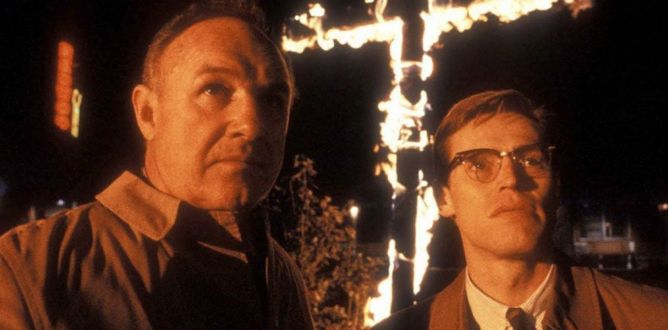Mississippi Burning Parent Guide
A searing depiction of racial violence and the struggle to bring the perpetrators to justice.
Parent Movie Review
Those of us who are too young to remember the Civil Rights Movement too often see it through a rosy haze of non-violent protests, soaring rhetoric, and a victory won in a righteous cause. Mississippi Burning reminds us that this part of American history is also a story of fire, blood, hate, and terror – and that there’s still a long way to go.
Mississippi Burning is a fictional movie, but it’s loosely based on a real event, the June 1964 murder of three civil rights activists – Michael Schwerner, Andrew Goodman, and James Chaney. In the film, the young men remain nameless and the story is focused on the efforts of the FBI agents tasked with tracking down their murderers. Agent Alan Ward (Willem Dafoe) is a rising star in the agency, bullet-scarred and tested in the trenches. He’s determined to run a textbook investigation and clear the case with dispatch. His junior is Rupert Anderson (Gene Hackman), some years older, with his own life experience as a sheriff in Mississippi.
The story gains its tension from two conflicts: the first between the FBI and the local sheriff’s office, which is determined to protect the killers; and the second, between Ward and Anderson who are at loggerheads over strategy. Both conflicts heat up in an atmosphere of brutal, pervasive cruelty.
It’s difficult to overstate the amount of violence in this film – but it’s not surprising given the horrors perpetrated by the Ku Klux Klan on African Americans for generations. Mississippi Burning doesn’t ignore or sugarcoat the savagery of the time – there are two scenes of lynchings, repeated scenes of physical assault (including the punching and kicking of a child leaving church), a riot involving assault and arson, and multiple images of black-owned homes and churches being set on fire. I don’t think this film goes more than ten minutes at a stretch without a violent episode. Even the FBI gets in on the action, with Anderson deploying dirty tricks, including kidnapping a suspect and threatening him with castration. When Ward protests that illegal tactics put the FBI in the gutter, Anderson’s response is “They crawled out of the sewer. Maybe the gutter’s where we should be.” That’s certainly where they wind up.
Given the sheer viciousness of some of the film’s scenes (and the 60+ profanities and racial slurs), parents and teachers are going to want to carefully consider showing this movie to teens. It accurately depicts the fiery terror of the civil rights era in the deep South and forces viewers to confront their own feelings on issues such as race, segregation, and policing but that knowledge comes at the cost of watching deeply disturbing images.
I struggle with the content issues in Mississippi Burning because, although they are pervasive and troubling, they are true to the time and removing them would lessen the impact of this film. Should this movie be widely watched? Yes. Should it be watched by teens? That’s a question that will need to be determined by teachers and parents on an individual basis. The violence is disquieting, but it’s also part of history – and the current reality for many young people. Perhaps movies like this, by showing the agony of racial violence, will motivate us to bring it to an end.
Directed by Alan Parker. Starring Gene Hackman, Willem Dafoe, and Frances McDormand. Running time: 128 minutes. Theatrical release January 27, 1989. Updated June 8, 2020Watch the trailer for Mississippi Burning
Mississippi Burning
Rating & Content Info
Why is Mississippi Burning rated R? Mississippi Burning is rated R by the MPAA
Violence: There are multiple scenes of churches, homes, barns and other structures being set on fire. Burned farm animals are briefly seen. There are frequent scenes of physical assault involving punching, hitting, kicking, and attacking with sticks – victims are shown dead or seriously injured. In an egregious incident, masked men carrying metal bars attack worshippers leaving church. A child is punched and kicked in the face and abdomen by a Klan member. A photo is seen of a black man who has been lynched. A beaten man is thrown from a moving car. Firearms are used and people are killed. In more than one scene, guns are put to men’s heads. Shotguns are fired through people’s windows as a warning. Burning crosses are seen. There are two scenes of men being lynched – hung from a tree with a noose. A man is kidnapped, manacled, and taken to a remote house where he is terrorized. A man threatens to castrate another man with a razor blade. A main character mentions being shot. A woman is brutally beaten by a man; she is shown with blood, cuts, and bruises. A character grabs a man by the neck and then grabs his genitals. Police officers attack a reporter and seize his camera. Angry citizens riot and set fires. A character menaces another man with a razor blade, cutting his face. He also beats him and holds his head under water.
Sexual Content: Adultery is implied. A man describes another man being violently castrated by the Klan. He threatens to castrate another man and holds a razor blade to his pants.
Profanity: There over four dozen swear words in the movie, including eight sexual expletives, a dozen scatological curses, ten terms of deity as well as anatomical terms and minor profanities. The movie also contains frequent racial slurs, including at least 22 uses of the “n-word” and another racial slur. A demeaning term for Jews is also used as is a homophobic slur.
Alcohol / Drug Use: Men are shown drinking beer with meals and in a bar. A man is shown intoxicated. A police officer drives while drinking beer. Characters occasionally smoke cigarettes.
Page last updated June 8, 2020
Mississippi Burning Parents' Guide
One of the most unsettling things about watching Mississippi Burning is listening to the man-on-the-street interviews with white Mississippians. Many of the things they say are still being heard in the national discourse. What comments stand out to you? Why do you think these issues are still being discussed in the same way?
Why do you think people were willing to look the other way when the knew or suspected the KKK was killing African Americans? What can we do to prevent hate groups from flourishing in our communities and countries?
Loved this movie? Try these books…
The murders this movie is based on are exhaustively detailed in We Are Not Afraid. Based on FBI records and interviews, the book was researched and written by Seth Cagin and Philip Dray. Another account of these murders is found in Three Lives for Mississippi by William Bradford Huie.
The police investigation in this movie is recounted in Don Whitehead’s Attack on Terror: The FBI Against the Ku Klux Klan in Mississippi.
Many racially motivated murders in the Deep South were not prosecuted for decades. For more about these cases, you can read Jerry Mitchell’s Race Against Time: A Reporter Reopens the Unsolved Murder Cases of the Civil Rights Era.
John Lewis recounts his experiences in the civil rights in the three part graphic novel March. He has also written a memoir entitled Walking With the Wind.
Home Video
Related home video titles:
In Burden, a young white man leaves the Ku Klux Klan with the help of an African-American pastor.
The cruelty of segregation comes to the big screen when a white man is hired to be a chauffeur and body guard for an African American pianist who is going on tour in the South in Green Book.
African Americans march for voting rights in Alabama in Selma. Starring David Oyelowo as Martin Luther King, Jr., this is an excellent civil rights film.
Not all African Americans chose non-violent protest. Malcolm X tells the story of this charismatic leader who advocated that black Americans defend themselves, forcibly if necessary, from the violence perpetrated against them.

